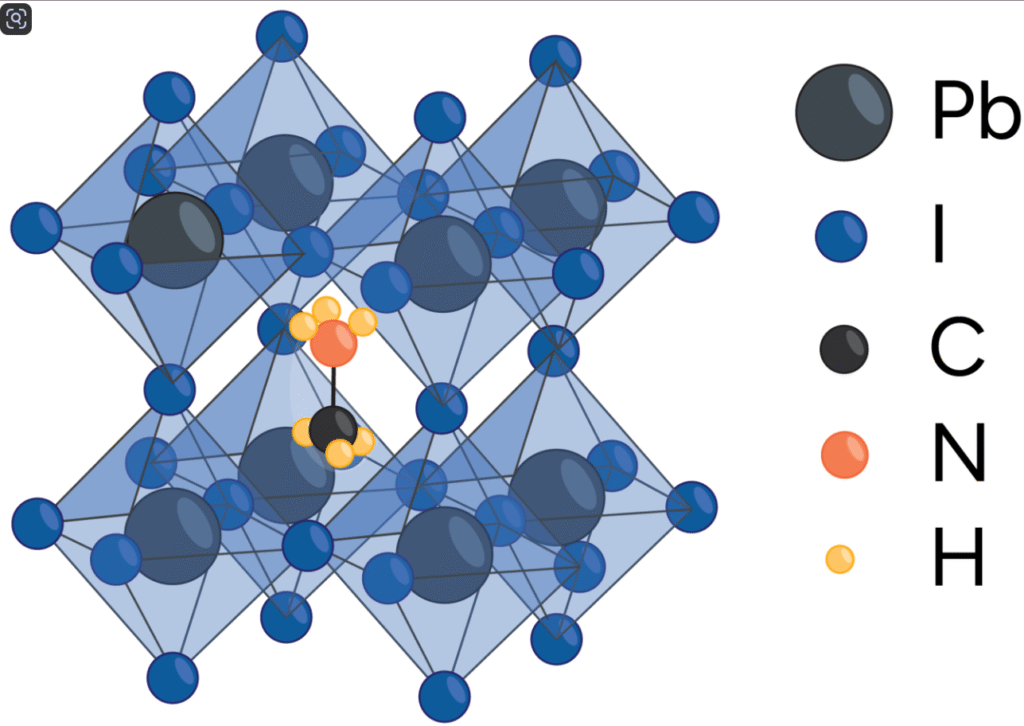
Introduction to Perovskite Solar Cells
Perovskite solar cells 2025 are setting new records in efficiency and innovation, positioning themselves as one of the most promising next-generation solar technologies. In 2025, single-junction perovskite cells achieved a certified efficiency of 26.7%, while perovskite-silicon tandem cells reached an impressive 34.85%, according to Fluxim. These breakthroughs could make perovskite a competitive alternative to traditional silicon-based panels, with the potential to deliver more power from the same surface area.
Perovskite is a group of materials characterised by a unique crystal structure, similar to the natural mineral calcium titanate (CaTiO₃). This structure, known as the perovskite structure, follows the general formula ABX₃. These materials have gained significant attention, especially in solar cell technology, because of their promising efficiency and low production costs.
Are we on the brink of a solar energy revolution? Perovskite solar cells have emerged as a game-changer in the renewable energy landscape, boasting the potential for significantly higher efficiencies and lower production costs compared to traditional solar technologies. As we dive deeper into this topic, we will uncover the latest advancements and innovations in this exciting field.
In this article, we will explore the state of perovskite solar cell technology, highlighting recent breakthroughs in efficiency and examining the hurdles that still need to be overcome for commercialization. By analyzing how these cutting-edge cells compare to conventional solar options, we aim to provide insights into when we might see them hit the market. Join us as we navigate the future of solar energy with perovskite technology, and consider how these innovations could reshape our energy landscape by 2025.




Understanding Perovskite Solar Cell Technology
Perovskite solar cells represent a transformative leap in photovoltaic technology. At their core, these cells utilize a unique crystal structure known as perovskite, typically composed of organic-inorganic hybrid materials, allowing for exceptional light absorption and charge-carrier mobility. The most common form of perovskite material used in solar cells is a combination of methylammonium lead halide, which facilitates efficient light trapping.

Basic Principles of Operation
The operational principles of perovskite solar cells are fascinating yet straightforward. When sunlight strikes the cell, the perovskite layer absorbs photons, exciting electrons and creating electron-hole pairs. These charge carriers are then separated and directed toward the respective electrodes, generating electrical power. This dynamic process is responsible for the high efficiency rates observed in lab environments.
Composition and Benefits
What sets perovskite solar cells apart is not just their composition, but also their flexibility and ease of fabrication. They can be produced using low-cost and scalable methods, such as solution-processing techniques, which make them a cost-effective alternative to traditional silicon-based solar cells. In fact, the lightweight and flexible nature of these cells positions them for application in diverse settings, from residential rooftops to portable solar solutions.
We have witnessed experiments that combine perovskites with other materials, leading to hybrid solutions that further enhance the energy conversion efficiency. For example, integrating perovskite layers with tandem solar cells can surpass the 30% efficiency mark, a significant improvement over conventional technologies that typically hover around 20% for silicon solar cells.
As we continue to explore recent breakthroughs in efficiency that put perovskites in the spotlight, it is essential to understand the challenges that lie ahead. This foundational knowledge not only enriches our understanding of perovskite solar cell technology but also sets the stage for a discussion about its commercial viability and potential impact on the energy market.
Recent Breakthroughs in Efficiency
The recent strides in perovskite solar cell technology are marked by astonishing gains in efficiency, capturing the interest of researchers and industry stakeholders alike. In our pursuit of sustainable energy solutions, we’ve observed key innovations that redefine the performance potential of these cells.
Enhancements in Material Composition
One significant advancement has been in the optimization of perovskite materials. Researchers have discovered that doping the perovskite layer with cesium improves thermal stability and efficiency. A study from the University of California, Berkeley, demonstrated that this method raised efficiency rates to an impressive 29.15% under standard test conditions, a breakthrough that solidifies perovskites as front-runners in solar technology.
Innovations in Cell Architecture
Moreover, architectural changes to the solar cells have efficiently enhanced their performance. For instance, the incorporation of 2D perovskite layers alongside traditional 3D structures combats the degradation commonly associated with humidity and temperature fluctuations. Recently, a team at the Swiss Federal Institute of Technology reported a tandem cell design using both perovskite and silicon that achieved a record efficiency exceeding 30%. These tandem architectures utilize the strengths of both materials, allowing for a higher rate of light absorption and energy conversion.
Real-World Applications
In practical applications, we have seen early-stage commercialization efforts utilizing these cutting-edge perovskite materials. Companies like Oxford PV are already testing perovskite-silicon tandem cells in real-world environments, laying the groundwork for broader adoption. Pilot projects have shown that deploying these high-efficiency cells not only generates more power but also reduces the land footprint required for solar installations, a crucial factor in urban settings.
These breakthroughs in efficiency represent just the beginning of what is possible with perovskite solar technology. As we look toward the next section, we will delve deeper into the challenges and barriers to commercializing these remarkable innovations, ensuring we understand the complexities ahead in bringing perovskite solar cells to the global market.
Challenges in Commercialization
Despite the groundbreaking advancements in perovskite solar cell technology, we face significant hurdles in translating these innovations from the laboratory into widespread commercial application. Understanding these challenges is critical for stakeholders who are eager to harness the full potential of this promising energy solution.
Stability and Longevity
One of the foremost challenges remains the stability of perovskite materials. Unlike traditional silicon cells, perovskite solar cells are sensitive to environmental factors such as moisture and temperature fluctuations, which can lead to rapid degradation. Research published in Nature Energy has shown that certain formulations can lose up to 80% of their efficiency within just a few months under real-world conditions. To combat this, researchers are exploring various encapsulation methods and material compositions, but a universally effective solution remains elusive.
You Might be Interested on this Post: Smart Glasses vs Smart Helmets: Which Is Better for Industrial Safety?
Scalability and Manufacturing
Scalability is another pressing issue. While laboratory settings have demonstrated astonishing efficiency rates and innovative designs, scaling these processes to industrial levels poses significant challenges. Current manufacturing methods, such as spin-coating and spray-coating, are often slow and less efficient than traditional silica-based production methods. We need to identify large-scale production techniques that are not only cost-effective but also maintain the high performance levels achieved in lab settings.
Regulatory Hurdles
Regulatory compliance also plays a vital role in the commercialisation of perovskite solar cells. As new materials and technologies emerge, there is a pressing need for clear guidelines to ensure product safety and reliability. Regulatory bodies are still evaluating how perovskite materials perform over extended periods and their potential environmental impacts. Achieving standardisation will be crucial for gaining public trust and investor confidence.
Market Acceptance
Finally, market acceptance can be a slow process. Traditional solar technologies have a well-established presence and a clear performance record, while perovskite cells, despite their potential, need to prove their long-term reliability before they can effectively compete. We must engage in robust educational initiatives and awareness campaigns to inform stakeholders about the benefits of this new technology.
As we address these multifaceted challenges, it is essential to think strategically about the path forward. The interplay between innovation and commercialisation will dictate how and when perovskite solar cells can become a mainstream energy solution. In our next section, we will explore how these lightweight cells compare to traditional solar technologies, shedding light on their unique advantages and potential pitfalls.
Comparative Analysis with Traditional Solar Technologies
When examining the landscape of solar energy solutions, we can directly juxtapose perovskite solar cells against the conventional silicon-based solar panels that have dominated the market for decades. This comparison allows us to assess their relative advantages and disadvantages, ultimately helping us gauge where perovskite technology stands in the grand scheme of energy innovation.
Efficiency and Performance
Manufacturing and Cost
Stability and Durability
Form Factor and Versatility
As we dissect these contrasting characteristics, it becomes clear that while perovskite solar cells offer thrilling advancements, challenges remain to secure their position among established technologies. The journey toward overcoming these hurdles leads us to explore more about the market predictions for these innovative cells and potential timelines for their widespread adoption.
Market Predictions and Timelines
As we advance into 2025, excitement around perovskite solar cells continues to grow, but when can we realistically expect to see these technologies in the market on a large scale? In this section, we will explore expert predictions regarding commercialisation, taking into account key factors such as investment trends, technology maturation, and market demands.
Timelines for Market Introduction
Market experts suggest that by 2025, we could see perovskite solar cells begin to transition from pilot projects to commercial products. A recent report from the International Energy Agency points toward 2025-2027 as a potential window for initial commercial deployment, especially for tandem solar technology that combines silicon and perovskite layers.
Investment Trends
Investment in renewable energy, particularly in solar technology, is surging. According to Bloomberg New Energy Finance, global investment in solar power reached $160 billion in 2022 and is expected to grow as governments and private sectors prioritise clean energy. This influx of funds is accelerating the development of manufacturing processes and supply chains necessary for perovskites to thrive.
Technological Maturation
The maturation of production technologies is another critical factor. While today’s efforts are concentrated in research facilities, investors are optimistic that optimised manufacturing methods, such as roll-to-roll printing, will streamline production costs. As these technologies reach industrial readiness, scalability will also come into play, with predictions indicating that mass production could be feasible as early as 2027.
Market Demand
Furthermore, increasing global demand for renewable energy options provides a fertile ground for perovskite solar cells. As countries commit to reducing carbon emissions and enhancing energy security, perovskites could fill a vital niche, particularly in markets where space is limited. The ability of perovskites to deliver high efficiency in smaller footprints positions them perfectly for urban installations.
As we navigate through these market conditions, it becomes evident that the integration of perovskite solar cells into the mainstream energy landscape is on the horizon. The prospect of overcoming existing hurdles is compelling, especially as we pivot to examining the future of solar energy with this technology, which holds transformative potential for how we harness and utilize sunlight.
The Future of Solar Energy with Perovskite Technology
As we peer into the horizon of solar energy, the widespread adoption of perovskite solar cells promises to redefine our energy landscape dramatically. This innovative technology has the potential to revolutionise not only how we generate electricity but also how we view renewable energy as an integral part of a sustainable future.
Enhancing Efficiency and Access
One of the foremost implications of perovskite technology is its possibility for enhanced energy efficiency. With recent laboratory efficiencies exceeding 29%, these cells can generate more energy from the same amount of sunlight compared to traditional silicon solar panels. This heightened efficiency can lead to more compact installations, making solar energy accessible even in urban environments where space is limited. We can envision rooftops adorned with sleek, lightweight perovskite cells seamlessly integrated into building designs, promoting aesthetic appeal while maximising energy output.
Contributing to Global Sustainability Goals
Widespread adoption of perovskite technology could significantly contribute to achieving global sustainability targets. As nations strive to meet their carbon neutrality commitments, the affordability and flexibility of perovskite solar cells could enable a faster transition away from fossil fuels. The use of abundant materials in their production aligns with circular economy principles, reducing environmental impacts associated with mining and material sourcing.
Energy Independence
Additionally, the potential for localised energy generation can foster greater energy independence. By facilitating residential solar installations that perform exceptionally well in varying lighting conditions, we can empower homeowners and communities to produce their own electricity. This shift can alleviate stress on ageing energy grids and diminish reliance on centralised power sources, making robust local energy systems a reality.
Progressing Toward Large-Scale Integration
As we look ahead, the efforts to overcome current challenges present a palpable momentum toward large-scale integration of perovskite solar cells. We envision scenarios where these cells complement existing technologies, such as tandem systems that enhance overall energy capture.
Through collaborative research, technological innovation, and informed policy-making, we can unlock the transformative potential of perovskite solar cells, steering society toward a renewable energy future.
As we discuss these hopeful prospects, we are reminded that the road ahead is still fraught with questions and challenges, but the energy transition awaits us with endless possibilities. This then leads us to our concluding thoughts on the path forward for perovskite solar cells.
Conclusion: The Road Ahead for Perovskite Solar Cells
As we’ve explored, perovskite solar cells hold transformative potential with their remarkable efficiency advancements and versatility in application. Despite challenges in commercialisation, including stability and scalability, the strides made in recent years provide a promising outlook. With ongoing research and innovation, we can anticipate a significant impact on the renewable energy landscape by 2025 and beyond.
We remain committed to monitoring developments in perovskite technology and its implications for solar energy. As we navigate this exciting frontier, we encourage our readers to stay informed and consider the opportunities that lie ahead in the pursuit of sustainable energy solutions. The journey is just beginning, and together, we can pave the way for a brighter, greener future.








I love that these cells could make solar power more accessible! 🙌 Just hoping they don’t cost an arm and a leg when they arrive.
I think the competition will drive prices down, so fingers crossed!
Right? If they’re affordable, it could really change the game for a lot of people.
I’m intrigued but also hesitant. How do we know these are better than what we have now? Anyone done a side-by-side comparison?
I’d love to see some real-world tests! That would help clear things up.
That’s a fair point, Logan. A comparative analysis is crucial, and many researchers are working on that to provide solid data.
Wow, these perovskite solar cells sound amazing! 😍 I love how they could revolutionize the energy market. I wonder how they compare to traditional solar panels in everyday use? Anyone tried the Renogy 200W yet?
I haven’t tried the Renogy, but I’ve heard good things! I think the efficiency boost with perovskite might make a big difference in the long run.
Great question, Emily! The efficiency of perovskite cells is significantly higher than traditional silicon cells, especially in low-light conditions.
I’m skeptical about the commercialization timeline. They always say ‘next year’ for solar tech, but it never seems to happen. 🤔 What’s the hold-up?
Totally get that, Liam. It feels like we’ve been hearing about breakthroughs forever. But I guess it’s better to take time and get it right!
You’re right, Liam. The commercialization is tricky due to stability issues and manufacturing costs. But there’s real progress!
My concern is about waste. What happens with these cells at the end of their life? Are they recyclable?
That’s an important question, Henry! Recycling methods are being developed, but it’s still a work in progress.
Exactly! We need to make sure we’re not creating more waste with new tech.
Perovskite cells are the future! 🌍 Can’t wait for them to hit the market. I’ve been eyeing that Comprehensive Guide to Perovskite Solar Cells—sounds like a must read!
Absolutely, Olivia! The guide is a great resource to understand the technology better.
I’ve got the guide! It’s super informative and covers a lot of ground.
I love the idea of mini solar cells! The SUNYIMA Mini Monocrystalline Solar Cells Kit looks fun! Anyone tried it?
I’ve heard good feedback about the mini kits! They’re great for small projects.
I’ve used one! It’s perfect for DIY projects or even just powering small devices.
The future of solar energy looks exciting! I’m all for tech that helps the planet. 🌱 How can we get involved in the research?
There are a lot of local initiatives too! Would be cool to get involved with some hands-on projects.
You can participate by following updates from research institutions or even joining community solar programs!
The efficiency breakthroughs sound promising! Would love to see more studies on long-term performance. Has anyone looked into that?
There are ongoing studies about their longevity. So far, results are encouraging, but long-term data will be vital.
I’ve heard they’re working on improving stability, which is a good sign!
I just bought a Werchtay 200W High Efficiency Solar Panel. Should I wait for the perovskites? 🤔
If you need a panel now, the Werchtay is a good choice! But if you can wait, perovskites might be worth it.
Yeah, if you can hold off, it could be a game-changer. But the Werchtay is solid!
Does anyone know if these cells can work in extreme weather? I live in a place that gets crazy storms. 🌧️
Good question, Charlie! Perovskite cells have shown resilience, but they might need additional protective measures in extreme climates.
I wonder how the All Black 200W Monocrystalline compares to these new cells. I’m kind of in the market for a new panel. 🤷♀️
Good question! The All Black is sleek, but the perovskite cells promise higher efficiency. Might be worth waiting a bit!
Great point, Ava! The aesthetics of the All Black are nice, but perovskite could outshine it in performance.
I’m all for renewable energy, but I’m worried about the environmental impact of producing these cells. Anyone else concerned?
That’s a valid concern, Grace! The production process is still under scrutiny, but researchers are working on sustainable methods.
Exactly! We need to ensure that going green doesn’t mean dirty production methods.